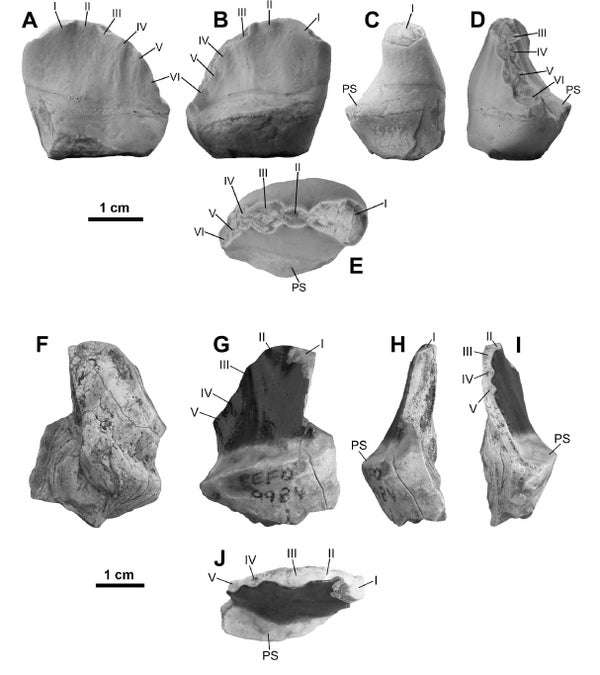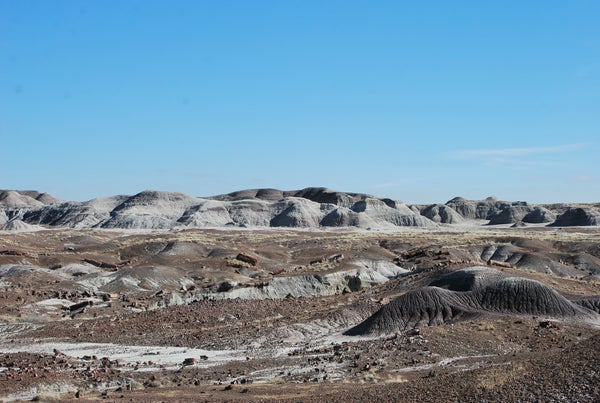This article was published in Scientific American’s former blog network and reflects the views of the author, not necessarily those of Scientific American
Dinosaurs are our ambassadors to the deep past. There’s hardly a better example of this fact than the Triassic. This stretch of time, the first chapter of the three-part Mesozoic epic, is often referred to as the Dawn of the Dinosaurs and ran from about 250 to 200 million years ago. This is despite the fact that dinosaurs were minor players in the Triassic drama.
Sure, the first dinosaurs evolved by about 235 million years ago, but they were small and ecologically marginal animals for most of the period. The true rulers of the Triassic world were stranger creatures, many of them more closely related to crocodiles, and we are only just now becoming acquainted with the various species that we’ve let dinosaurs overshadow. The Triassic menagerie is far weirder than previous generations of paleontologists expected, and it’s only set to get more bizarre. Consider Kraterokheirodon.
Nobody knows what Kraterokheriodon is. The nature of this animal is totally inscrutable, joining the ranks of species like the Tully Monster in the ranks of fossil Problematica. But the two fossil teeth that represent this animal signal that there was something very odd shuffling around the Late Triassic of Arizona. Paleontologists Randall Irmis and William Parker, who named Kraterokheriodon in 2005, followed the fossil trail as far as they could.
The story of the “cupped hand tooth” started in 1946. It was in that year that geologist G.E. Hazen found an unusual tooth from the Triassic Chinle Formation of Arizona and gave the tooth to paleontologist Edwin Colbert. It was unlike any fossil found before, having a curved, shell-like shape. And that’s as far as the story of the tooth went until 1984, when Lynette Gillette found a similar tooth in Petrified Forest National Park. This was enough to reignite Colbert’s interest, although he couldn’t confidently assign the teeth to any known group. He was still studying them when he passed away in 2001.
On supporting science journalism
If you're enjoying this article, consider supporting our award-winning journalism by subscribing. By purchasing a subscription you are helping to ensure the future of impactful stories about the discoveries and ideas shaping our world today.

A cast (top set) and fossil of Kraterokheriodon. Credit: Irmis and Parker 2005
Paleontologists Robert Long and Phillip Murry had an idea about who those teeth originally belonged to. In a 1995 paper, they proposed that the strange teeth were those of herbivorous protomammals called traversodont cynodonts. That’s why these animals had such a big role in the Petrified Forest episode of Walking With Dinosaurs. But Irmis and Parker didn’t find any direct support for this idea in their analysis of the fossil. (Hazen’s initial find is now only known as a cast, with the original missing, making Gillette’s find the only existing specimen.) The furthest they were able to narrow their identification of Kraterokheriodon colberti was Amniota, the major group that includes mammals, reptiles, and their closest relatives.
Kraterokheirodon is so bizarre, Irmis and Parker explained, that it’s difficult to understand how the unusual teeth even fit into the animal’s mouth. The fossils definitely are teeth – there’s enamel, dentine, a root, and other details which confirm this – but the certainties don’t go much further than that. The teeth don’t resemble those of lungfish, bony fish, or amphibians. And while the Kraterokheriodon teeth somewhat resemble those of some cynodonts, Irmis and Parker wrote, they are far larger and the superficial similarities may be a case of convergence rather than family relationships.
Ultimately, Irmis and Parker concluded, “the recognition of these teeth as a new and unique taxon is a reminder of how little is still known about the fauna of the Late Triassic Period.” That’s certainly understating how frustrating the lack of additional material has been. Based upon the size of the teeth, Kraterokheriodon must have been a large animal. This was not a small, delicate creature unlikely to fossilize. This was an animal that should have had similar fossilization potential to the phytosaurs, aetosaurs, dinosaurs, and other big-bodied fauna of Arizona’s Late Triassic. So where is it? The experts who explore the Petrified Forest continually ask themselves that question as they wander out into the Painted Desert. Somewhere out there, the key to Kraterokheriodon is waiting.
Reference:
Irmis, R., Parker, W. 2005. Unusual tetrapod teeth from the Upper Triassic Chinle Formation, Arizona, USA. Canadian Journal of Earth Sciences. doi: 10.1139/e05-031
